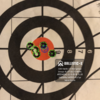Not at all.

There was just more to it then that, with that test.
If one is testing for velocity, or accuracy or whatever, everything should be as exactly the same as can be, save for the single test variable.
I haven’t used my chronograph very much, not as much as I thought I would.

Something I notice a while back when doing a load work up...
All: Lapua brass. (REDACTED)grains CFE223 CCI450s Hornady 75 BTHP
Variable: seating depth CBTO length.
5: 1.929”=+.016 interference
5: 1.926”=+.010
5: 1.919”=+.003
5: 1.916”= 0
5: 1.910”= -.006
5: 1.906”=-.016
5: 1.896”=-.026
5: 1.886”=-.036 jump
I don’t know why I chose the numbers I did instead of fives...

I shot these shortest to longest. The groups got slightly tighter the closer to the lands they were.
Those that were right on, .003 in and .010 in were visually the same shape and size, just printing slightly higher in relation to point of aim.
Whether this was from my barrel releasing them slightly later in the harmonic wave, or they had slightly less drop from increased speed, I am unsure. I need a LabRadar!

The one with the most interference was slightly larger, perhaps from a pulled shot, but the firing pin hole primer extrusion was looking rather proud, so judged “too much”.
So it does increase pressure slightly. But I think there is a limit to it. The bullet will go down the bore eventually, and the amount of powder is the ultimate source of pressure, whether that makes a little more speed, or sticks a bolt or pops a primer out is more dependent on the powder charge.
Whew! That was a lot. Which brings me to the important question...
How did it shoot?







